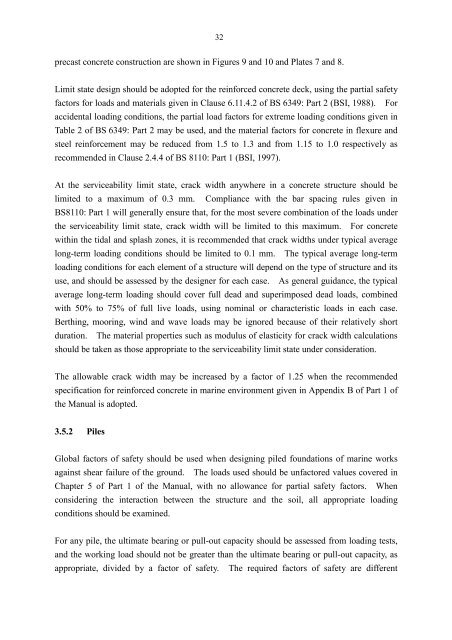Port Works Design Manual : Part 2
Port Works Design Manual : Part 2
Port Works Design Manual : Part 2
- No tags were found...
Create successful ePaper yourself
Turn your PDF publications into a flip-book with our unique Google optimized e-Paper software.
32precast concrete construction are shown in Figures 9 and 10 and Plates 7 and 8.Limit state design should be adopted for the reinforced concrete deck, using the partial safetyfactors for loads and materials given in Clause 6.11.4.2 of BS 6349: <strong>Part</strong> 2 (BSI, 1988). Foraccidental loading conditions, the partial load factors for extreme loading conditions given inTable 2 of BS 6349: <strong>Part</strong> 2 may be used, and the material factors for concrete in flexure andsteel reinforcement may be reduced from 1.5 to 1.3 and from 1.15 to 1.0 respectively asrecommended in Clause 2.4.4 of BS 8110: <strong>Part</strong> 1 (BSI, 1997).At the serviceability limit state, crack width anywhere in a concrete structure should belimited to a maximum of 0.3 mm. Compliance with the bar spacing rules given inBS8110: <strong>Part</strong> 1 will generally ensure that, for the most severe combination of the loads underthe serviceability limit state, crack width will be limited to this maximum. For concretewithin the tidal and splash zones, it is recommended that crack widths under typical averagelong-term loading conditions should be limited to 0.1 mm. The typical average long-termloading conditions for each element of a structure will depend on the type of structure and itsuse, and should be assessed by the designer for each case. As general guidance, the typicalaverage long-term loading should cover full dead and superimposed dead loads, combinedwith 50% to 75% of full live loads, using nominal or characteristic loads in each case.Berthing, mooring, wind and wave loads may be ignored because of their relatively shortduration. The material properties such as modulus of elasticity for crack width calculationsshould be taken as those appropriate to the serviceability limit state under consideration.The allowable crack width may be increased by a factor of 1.25 when the recommendedspecification for reinforced concrete in marine environment given in Appendix B of <strong>Part</strong> 1 ofthe <strong>Manual</strong> is adopted.3.5.2 PilesGlobal factors of safety should be used when designing piled foundations of marine worksagainst shear failure of the ground. The loads used should be unfactored values covered inChapter 5 of <strong>Part</strong> 1 of the <strong>Manual</strong>, with no allowance for partial safety factors. Whenconsidering the interaction between the structure and the soil, all appropriate loadingconditions should be examined.For any pile, the ultimate bearing or pull-out capacity should be assessed from loading tests,and the working load should not be greater than the ultimate bearing or pull-out capacity, asappropriate, divided by a factor of safety. The required factors of safety are different
















